History Of The Wartburg
Web page is supplied from www.peterfrost.clara.net
To view select Vechicles From Eastern Europe and Russia followed by Wartburg
The history of Wartburg cars goes back a long way, right back
as far as 1898 when the first cars were produced in Eisenach in
Germany.
Before the second world war a diverse range of vehicles were
produced at Eisenach including a version of the Austin 7 built
under licence called the Dixi. Before hostilities broke out the
Eisenach factories were part of BMW and were building high
quality cars and motorcycles.
After the war Eisenach became part of Communist ruled East
Germany. Production of cars and motorcycles restarted there with
modified versions of pre-war BMWs. Initially these were sold with
BMW badges, but this was quickly changed to avoid problems with
BMW in West Germany. Cars were then sold badged as Autowelo and
later as EMW (Eisenach Motoren Werke) as they were further
developed.
There was a great need in the Eastern Bloc countries for cars
that were simple to build, maintain, and own. There was also a
need to export cars and earn vital foreign currency. As a first
step to achieving this production of the IFA F9 car was moved to
Eisenach.
Before the war DKW had been developing a new 3 cylinder
2-stroke car. After the war development continued along divergent
paths in both East and West Germany. The East German version, the
IFA F9, was developed and initially produced in Zwickau by the
Sachsenring factory which was later to go on to produce the
Trabant.
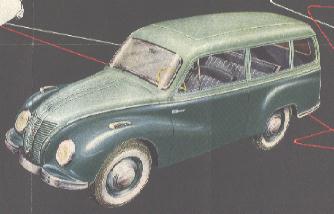 IFA F9 Estate
from mid 1950s
IFA F9 Estate
from mid 1950s
The F9 was exported to many countries including Europe and
South America (It was also manufactured under licence in South
America).
In the 1950s much work was carried out on development of a
new range of cars. The F9 was used as a starting point, so the
new cars featured a 900cc 3 cylinder 2-stroke engine and a
seperate 'perimeter' type chassis with independant suspension by
transverse leaf springs.
In 1956 the new range of cars started production with a wide
variety of models based on a common engine/chassis configuration.
This included a saloon, two estates, a coupe and convertible,
plus a 2 seat sports car and sports convertible. These cars bore
'Eisenacher' badges and were known as the 'typ Wartburg' and were
exported to many countries including Europe, South America, USA,
South Africa and China. For many markets the cars were simply
known as Wartburgs.
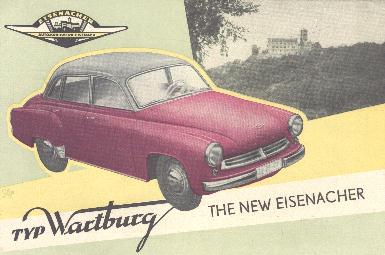
1956 brochure for the 'New Eisenacher Typ Wartburg'
The cars were built to a very high standard (as one would
expect from workers previously used to producing BMWs). Heavy
guage steel was used giving strong sturdy construction and much
use was made of polished aluminium castings and pressings. Some
of the cars featured wood and/or leather trim.
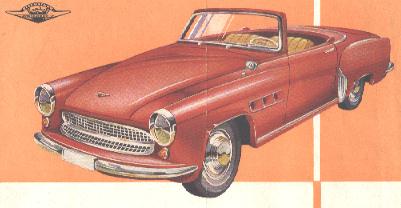
The rare (just under 500 made) Wartburg Sports
During production the range was expanded to include van and
pick-up versions plus a 4 door convertible was produced for
military and police use.
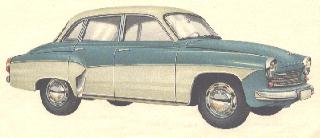 De-Luxe
Saloon
De-Luxe
Saloon
In the late 1950s a few Wartburgs were imported into Ireland,
but at this time the cars were still unknown in the UK.
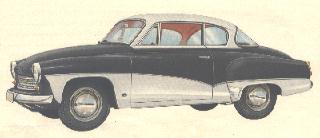 4 Seat
Coupe. Also available as a convertible
4 Seat
Coupe. Also available as a convertible
In 1962 the range of cars received its first major revision,
the basic body style was retained but the car had many
improvements which included increasing the engine size to 992cc
with major improvements to the cooling system, transmission and
drive train. At this time the cars continued with transverse leaf
spring suspension.
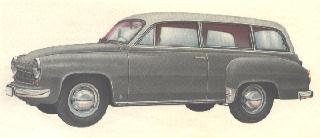 3 Door
Estate
3 Door
Estate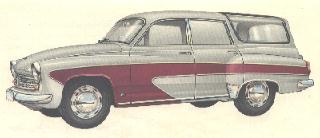 5 Door
'Kamping' Estate
5 Door
'Kamping' Estate
In 1963 the first right hand drive cars were built for
Cyprus, and the Wartburg range of cars was displayed for the
first time at the London Motor Show (along with Trabants !). An
agreement was reached with Industria Ltd to import the cars into
the UK (Industria had previous experience of dealing with Eastern
Bloc countries as they were already importing Jawa and CZ
motorcycles from Czechoslovakia). Industria set up a network of
dealers in the UK and the first cars were sold in 1964.
Initially only 4 door saloon cars were sold in the UK, about
300 of these RHD cars were imported, together with an odd one or
two 3 door estate cars.
In 1965 the range of cars received its second major revision,
again the basic body style was retained but underneath the car
was all new featuring a new chassis with coil spring suspension,
a much revised more powerfull engine and many more improvements.
A big selling point of this model was its 30,000 mile service
interval - this was at a time when many cars needed servicing
every 3,000 miles !
Between 1965 and 1967 about 450 RHD Saloons and just under
100 RHD Estates were imported into the UK.
In 1966 a completely new car was announced. This featured a
much more modern body but underneath was a perimiter chassis and
3 cylinder 2-stroke engine obviously developed from the previous
cars. There were two main models produced: a 4 door saloon and a
5 door estate.
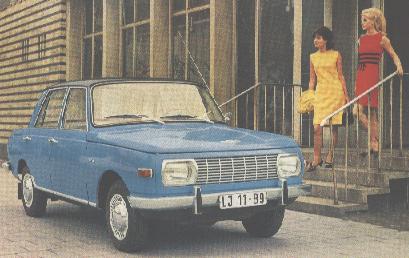 Knight
Saloon
Knight
Saloon
This new range was given the model number 353 and the estate
was called the 'Tourist'. For the UK market (and some others ?)
the saloon was called the 'Knight'.
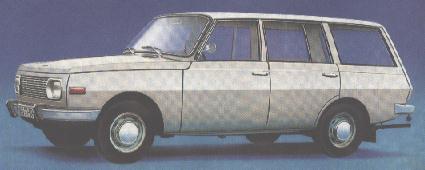 Tourist
Estate
Tourist
Estate
Whilst on sale in the UK between 1967 and 1976 the cars
underwent 3 major revisions culminating with the Mark 4
introduced in 1971.
A total of 19472 right hand drive Wartburgs were officially
exported to the UK between 1964 and 1976.
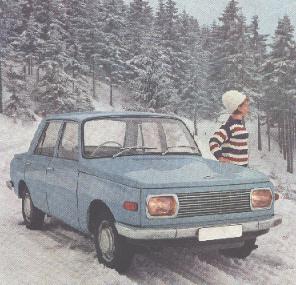
After 1976 development of the cars continued in East Germany
with further improvements made from time to time. Various cars
were personally imported and additionally there were a couple of
attempts to import cars on a small scale commercially. Right hand
drive cars were no longer available but many cars imported with
left hand drive were converted.
In 1988 Wartburg entered into an agreement with VW to
produce, under licence, an adapted version of the 1300cc Golf
engine, and this was fitted to a new model the Wartburg 1,3. This
was visually similar to the previous model and remained in
production until 1991 when General Motors Opel division bought
the factory.
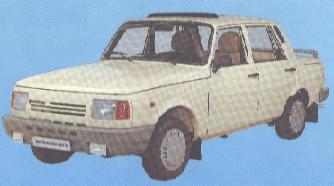 Wartburg 1.3
Wartburg 1.3
Web Page Coursty of Wartburg Trabant IFA Club UK
Back to Wartburg USA Main Page
 IFA F9 Estate
from mid 1950s
IFA F9 Estate
from mid 1950s IFA F9 Estate
from mid 1950s
IFA F9 Estate
from mid 1950s

 De-Luxe
Saloon
De-Luxe
Saloon 4 Seat
Coupe. Also available as a convertible
4 Seat
Coupe. Also available as a convertible 3 Door
Estate
3 Door
Estate 5 Door
'Kamping' Estate
5 Door
'Kamping' Estate Knight
Saloon
Knight
Saloon Tourist
Estate
Tourist
Estate
 Wartburg 1.3
Wartburg 1.3